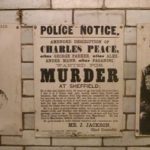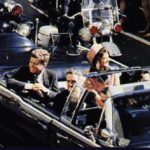 Weird Stuff
Weird Stuff  Weird Stuff
Weird Stuff  Our World
Our World 10 Ways Your Christmas Tree Is More Lit Than You Think
 Movies and TV
Movies and TV The 10 Coolest Stars to Set Sail on The Love Boat
 History
History 10 Things You Didn’t Know About the American National Anthem
 Technology
Technology Top 10 Everyday Tech Buzzwords That Hide a Darker Past
 Humans
Humans 10 Everyday Human Behaviors That Are Actually Survival Instincts
 Animals
Animals 10 Animals That Humiliated and Harmed Historical Leaders
 History
History 10 Most Influential Protests in Modern History
 Creepy
Creepy 10 More Representations of Death from Myth, Legend, and Folktale
 Technology
Technology 10 Scientific Breakthroughs of 2025 That’ll Change Everything
 Weird Stuff
Weird Stuff Ten Bizarre Facts About The Doge Meme
 Our World
Our World 10 Ways Your Christmas Tree Is More Lit Than You Think
 Movies and TV
Movies and TV The 10 Coolest Stars to Set Sail on The Love Boat
Who's Behind Listverse?

Jamie Frater
Head Editor
Jamie founded Listverse due to an insatiable desire to share fascinating, obscure, and bizarre facts. He has been a guest speaker on numerous national radio and television stations and is a five time published author.
More About Us History
History 10 Things You Didn’t Know About the American National Anthem
 Technology
Technology Top 10 Everyday Tech Buzzwords That Hide a Darker Past
 Humans
Humans 10 Everyday Human Behaviors That Are Actually Survival Instincts
 Animals
Animals 10 Animals That Humiliated and Harmed Historical Leaders
 History
History 10 Most Influential Protests in Modern History
 Creepy
Creepy 10 More Representations of Death from Myth, Legend, and Folktale
 Technology
Technology 10 Scientific Breakthroughs of 2025 That’ll Change Everything
Ten Interesting Tales of Trials Decided by Jury Nullification
Jury nullification is the practice of a jury of a defendant’s peers deciding to acquit the defendant in defiance of clear and incontrovertible guilt, typically because the jury considers the law in question or the punishment to be unjust or too harsh. Other nuances can come into play, and this list looks at ten examples.
Related: The Ten Most Followed Real-Life Criminal Trials in TV History
10 James Butler “Wild Bill” Hickok
Wild Bill Hickok became a hero of the American Old West largely because of a one-on-one shootout involving quick-drawing pistols between him and Davis Tutt, one of the very rare instances, possibly the first, of such a shootout ever transpiring. The shootout took place on July 21, 1865, in the town square of Springfield, Missouri. For months prior, Hickok and Tutt had a well-known feud stewing over women.
Hickok made his living almost exclusively by gambling in card games, and Tutt intended to bankrupt him by loaning money to other players and explaining to them how to beat Hickok. Hickok won about $200 of what was mostly Tutt’s money, and Tutt, incredibly frustrated to see this, took Hickok’s gold pocketwatch from the card table as collateral for a debt Hickok owed.
The watch was a gift from Hickok’s deceased father, and he highly prized it, but since most of the gamblers in the room were on Tutt’s side, Hickok decided to remain peaceful and asked for the watch back. Tutt took it and left. The next day, Tutt proudly wore the watch, and Hickok was resolved not to be humiliated, so they met in the square, both clearly armed. Hickok warned Tutt not to cross the square with the watch, but Tutt did so, and when he reached for his pistol, Hickok drew as well. Both men fired at the same time, and Tutt missed, but Hickok shot Tutt through the heart, and he died in the street. Hickok was arrested two days later.
Once all points of law were argued in the trial, the judge told the jury that they must find him guilty according to the law since Hickok could not legally claim self-defense as he had gone looking for the fight. Or they could decide against the law itself. The jury deliberated for one or two hours and acquitted Hickok completely, arguing that although it was not self-defense, it was “a fair fight.”[1]
9 Henry Morgentaler
Henry Morgentaler was born in Poland but emigrated to Canada, where he worked as a medical doctor who performed abortions on women in instances where giving birth might have killed the women. Canadian federal law prohibited abortions, and Morgentaler was tried three separate times for performing them in a flagrant violation of a law he felt was unjust.
As a doctor, he saw his services as saving lives and considered this more important than obeying the law in question. In his first trial in 1973, the question of whether he had broken the law was never in doubt. He and his lawyer simply argued against the justice of the law itself. A jury acquitted him in full, indicating their agreement with his defense. The Province of Quebec appealed this decision since the law is the law.
A year later, the Quebec Court of Appeal overturned the jury’s decision (a higher court had this power at the time). Morgentaler appealed to the Canadian Supreme Court, which agreed with the appellate court that he was guilty, and he thus wound up serving ten months in prison. He was vigorously defended throughout his career by women’s advocate groups.
In 1975, the Canadian Parliament, with a liberal majority, decided that a higher court could not overturn the decision of any 12-person jury, enabling the government to try Morgentaler again. This trial also resulted in a jury acquitting him since the people strongly disagreed with the justice of the law. The government appealed the acquittal, but this time, the appellate court upheld it.
A year later, the Canadian government decided that the anti-abortion law needed to be stricken from the books since no jury was ever going to enforce it. All other charges against Morgentaler (who was still performing abortions) were then dropped. He died in 2013 at the age of 90, but not before he was made a member of the Order of Canada.[2]
8 John Peter Zenger
John Zenger was a printer and publisher in New York City during the 1700s before America declared its independence from Great Britain. Since New York was still under British jurisdiction during Zenger’s life, the freedom of the press and freedom of speech were not officially guaranteed by any law. New York was governed by William Cosby, a British general remembered today as being very dictatorial during his five years governing the New York Colony.
In 1735, Zenger began publishing newspaper essays criticizing Cosby’s rule and character. This all stemmed from Cosby’s actions, upon being made the governor in 1732, in demanding half the salary, in addition to his own, from the outgoing governor, Rip Van Dam. When the colony’s Supreme Court ruled against Cosby, he fired its Chief Justice and replaced him with another more loyal to Cosby.
These were the actions Zenger criticized in his newspaper, and when he refused to stop, Cosby had him charged with libel and taken to court. Zenger ultimately spent over eight months in prison awaiting trial, and by the time it took place, Zenger’s plight had made him very popular with the people of New York.
The Chief Justice (who was clearly biased to Cosby who had installed him) refused to allow Zenger’s attorney, Andrew Hamilton, to defend him adequately, so Hamilton defended Zenger to the very jury itself. After only ten minutes of deliberation, the jury returned a verdict of not guilty, a clear and fearless defiance of Cosby’s rule. The entire courtroom cheered. The modern understanding of the freedom of the press is borne largely from this trial.[3]
7 William Penn
The founder and namesake of Pennsylvania was born in London in 1644. He was a devout Quaker and defender of “Primitive Christianity” as the only true religion. Because of the British Crown’s terrible intolerance of various religions—resulting in persecution, torture, and murder for centuries–Penn heroically published pamphlets and books strongly critical of the Crown and in favor of the freedom of religion.
Penn was imprisoned in the Tower of London in 1668 for publishing “Truth Exalted: To Princes, Priests, and People,” which openly defied the Church of England and, by direct extension, King Charles II himself. The Bishop of London decreed that Penn would never be let out of prison unless he recanted in writing everything he had published.
Penn refused, stating, “My prison shall be my grave. I owe my conscience to no mortal man.” This was an extremely brave act of defiance since, in those days, any man found guilty of treason would be executed by being hanged, castrated, disemboweled, and chopped to pieces. Penn was instead charged with blasphemy, and when he was given pen and paper, the Crown hoped he would recant so he could be released, as his popularity among the people was growing. Instead of recanting, he wrote his most famous book, No Cross, No Crown, which is still widely read today. In it, he defends Primitive Christianity and brazenly denounces the British Crown and its state-required Church of England.
The Crown set him free after eight months when it became clear that he would never recant, but in 1870, he was arrested along with William Mead, another Quaker, when they both deliberately preached in public defending Quakerism and denouncing Anglicanism. By law, Penn had the right to hear what charges he was facing, but the trial judge, Sir John Howel, refused to tell him. Howel then refused to let the jury hear any defense arguments and demanded that they convict both men.
The jury unanimously voted “not guilty” for both, openly defying the very monarchy. Howel immediately imprisoned the entire jury, along with Penn and Mead, and they were warned that they must change their verdict or starve to death. They still refused, and the result is remembered today as “Bushel’s Case,” which permanently established that a jury is free from the control of any judge and may choose any verdict as it sees fit. Penn, Mead, and the jury were ultimately set free.[4]
6 O.J. Simpson
O.J. Simpson’s trial is probably the most famous or infamous in American history, and his acquittal in 1995 may have been out of the jury’s fear of another city-wide riot (more on that in #3). The details of the case and trial are pretty well known. His wife, Nicole, and a man she was seeing extramaritally, Ron Goldman, were found stabbed to death in the Simpsons’ front yard.
Mountains of forensic evidence firmly pointed to Simpson as the murderer, but he had the money to assemble the “Dream Team” of defense attorneys led by Johnny Cochran. The riots of only three years earlier were fresh in the minds of everyone in Los Angeles, and the defense took full advantage of this in painting the police, especially Detective Mark Fuhrman, as racist against Black people. Cochran even told the jury that their verdict needed to send the police a message.
The trial lasted from January to October of 1995 and was by far the most watched and scrutinized trial in history. The verdict once again demonstrated a sharp racist divide between whites and Blacks in the United States. Historians generally agree that given how obviously guilty Simpson was, the jury’s verdict was based on either racist prejudice, fear of an ensuing riot, or both. The jury consisted of ten women and two men, and of these, two were white, nine were Black, and one was Hispanic.[5]
5 Lorena Bobbitt
Lorena Bobbitt was the Ecuadorian wife of John Wayne Bobbitt, who she claimed during her trial was horribly abusive to her and would routinely rape her when he wanted sex, but she wasn’t in the mood. On the night of June 23, 1993, after John came home and raped her again, he went to sleep. She got out of bed, returned from the kitchen with a butcher knife, and cut off his penis, then left the house and drove several blocks away before throwing the penis out the window into a field. It was later found and reattached. John subsequently starred in two pornographic films.
The story became famous nationwide, and at her trial, Bobbitt argued that John was so abusive that she finally snapped. Her defense argued that her constant fear of John and his terribly abusive attitude toward her caused her to become temporarily insane at the moment of the incident.
After seven hours, her jury acquitted her by reason of insanity. The jury foreman is on record for believing she was guilty. That she was acquitted despite this seems to indicate that the jury sympathized with her plight and that John deserved it.[6]
4 Marion Barry
Marion Barry was the mayor of Washington D.C. when, on January 18, 1990, he was caught on a surveillance camera during an FBI sting knowingly smoking crack cocaine. The FBI had used one of his former girlfriends to talk him into it, and he was charged with felony drug possession and perjury. His jury consisted of two white people and ten Black people.
About seven jurors, including the two whites, felt that the evidence of all the charges against Barry was overwhelming and that he was guilty. But the ultimate verdict was for conviction on only one drug possession charge and a complete and permanent deadlock on all the others. This was because five Black jurors were convinced that the prosecution had fabricated much of the evidence against Barry as part of a racist conspiracy to destroy him.
Barry ultimately served six months in prison and went on to be reelected as mayor of Washington in 1994. Had the jury convicted him of all charges, he would have served a much longer sentence.[7]
3 Stacey Koon, Laurence Powell, Timothy Wind, and Theodore Briseno
The four police officers who severely beat Rodney King and were subsequently acquitted of all charges in their state trial. The announcement of the verdict touched off the 1992 Los Angeles riots. Koon and Powell were later found guilty in a federal trial and served time.
Based on the video evidence of the beating, then-President George H. W. Bush commented, “Viewed from outside the trial, it was hard to understand how the verdict could possibly square with the video.” LAPD Chief Daryl Gates stated that after viewing the video 25 times, he still couldn’t believe how violent his officers had been.
Arguments have been raised ever since about how much of the video footage the jurors were able to see that was not broadcast on the news. The officers claimed that King had been combative with them for several minutes before the video began. The jury was comprised of nine white people, one biracial, one Asian, and one Latina. They acquitted three and were deadlocked on the fourth officer’s guilt, which set them all free. Although racism has been alleged ever since, none of the jurors ever issued any statement.[8]
2 John William Milam and Roy Bryant
These two men tortured and murdered 14-year-old Emmett Till on August 28, 1955, in Drew, Mississippi. As you might already know, an all-white jury exonerated them both after deliberating for only 67 minutes. One anonymous juror even bragged, “If we hadn’t stopped to drink pop, it wouldn’t have taken that long.”
Till had been accused by Roy’s wife, Carolyn, the owner of a small grocery store, of whistling at and roughly flirting with her. Milam was Roy’s half-brother. Bryant and Milam tracked down and caught Till, took him to a barn, pistol-whipped him nearly to death, shot him dead, and dumped his weighted body into a river.
Once the trial was over and the jurors found both men not guilty, they went on record stating that they believed Milam and Bryant were guilty, but they disagreed with the requirement that if guilty, both men would be sentenced either to death or life in prison. The jurors felt that either sentence was too harsh for a white person who killed a Black person in Mississippi.
Milam and Bryan both admitted in a magazine interview a year later, now that double jeopardy protected them, that they had beaten Till to death, and both men remained unapologetic for the rest of their lives.[9]
1 The Camden 28
On August 22, 1971, a group of 28 American citizens broke into the draft office in Camden, New Jersey, and destroyed or stole thousands of pages of draft documentation to protect the citizenry from being forced to participate in the Vietnam War. The draft was already roundly despised by the people, and it was because of anti-government actions like major protests and peace rallies that forced military conscription was ultimately ruled unconstitutional in 1973.
The 28 people who broke into the Camden draft office were being secretly surveilled by the FBI because one of their own, Bob Hardy, turned informant for the FBI. To this end, the raid was so well documented that the party’s guilt was unquestionable. They were all charged with seven felonies and could have gone to prison for over 40 years. They were tried as a group and offered, to begin with, a plea bargain: they could plead guilty to a single misdemeanor, and the rest would be dropped, a generous offer seen as the government’s fear of the public’s growing hatred of the draft.
The 28 people, men and women, conferred and refused the bargain, pleading not guilty to all felony charges. Howard Zinn, a prominent historian, testified in their defense during the trial and personally recommended to the jury that they should acquit everyone as an act of civil disobedience. The jury agreed, and on May 20, 1973, they returned verdicts that they were not guilty of every charge. All 28 walked out free.[10]








